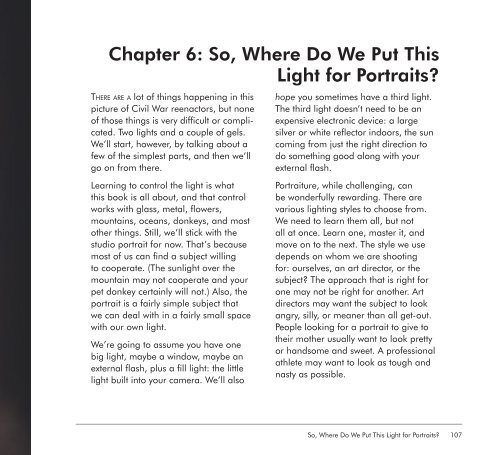Focus On Lighting Photos Focus on the Fundamentals.pdf
You also want an ePaper? Increase the reach of your titles
YUMPU automatically turns print PDFs into web optimized ePapers that Google loves.
Chapter 6: So, Where Do We Put This<br />
Light for Portraits?<br />
<strong>the</strong>re are a lot of things happening in this<br />
picture of Civil War reenactors, but n<strong>on</strong>e<br />
of those things is very difficult or complicated.<br />
Two lights and a couple of gels.<br />
We’ll start, however, by talking about a<br />
few of <strong>the</strong> simplest parts, and <strong>the</strong>n we’ll<br />
go <strong>on</strong> from <strong>the</strong>re.<br />
Learning to c<strong>on</strong>trol <strong>the</strong> light is what<br />
this book is all about, and that c<strong>on</strong>trol<br />
works with glass, metal, flowers,<br />
mountains, oceans, d<strong>on</strong>keys, and most<br />
o<strong>the</strong>r things. Still, we’ll stick with <strong>the</strong><br />
studio portrait for now. That’s because<br />
most of us can find a subject willing<br />
to cooperate. (The sunlight over <strong>the</strong><br />
mountain may not cooperate and your<br />
pet d<strong>on</strong>key certainly will not.) Also, <strong>the</strong><br />
portrait is a fairly simple subject that<br />
we can deal with in a fairly small space<br />
with our own light.<br />
We’re going to assume you have <strong>on</strong>e<br />
big light, maybe a window, maybe an<br />
external flash, plus a fill light: <strong>the</strong> little<br />
light built into your camera. We’ll also<br />
hope you sometimes have a third light.<br />
The third light doesn’t need to be an<br />
expensive electr<strong>on</strong>ic device: a large<br />
silver or white reflector indoors, <strong>the</strong> sun<br />
coming from just <strong>the</strong> right directi<strong>on</strong> to<br />
do something good al<strong>on</strong>g with your<br />
external flash.<br />
Portraiture, while challenging, can<br />
be w<strong>on</strong>derfully rewarding. There are<br />
various lighting styles to choose from.<br />
We need to learn <strong>the</strong>m all, but not<br />
all at <strong>on</strong>ce. Learn <strong>on</strong>e, master it, and<br />
move <strong>on</strong> to <strong>the</strong> next. The style we use<br />
depends <strong>on</strong> whom we are shooting<br />
for: ourselves, an art director, or <strong>the</strong><br />
subject? The approach that is right for<br />
<strong>on</strong>e may not be right for ano<strong>the</strong>r. Art<br />
directors may want <strong>the</strong> subject to look<br />
angry, silly, or meaner than all get-out.<br />
People looking for a portrait to give to<br />
<strong>the</strong>ir mo<strong>the</strong>r usually want to look pretty<br />
or handsome and sweet. A professi<strong>on</strong>al<br />
athlete may want to look as tough and<br />
nasty as possible.<br />
So, Where Do We Put This Light for Portraits?<br />
107



